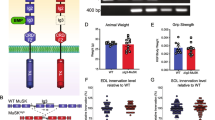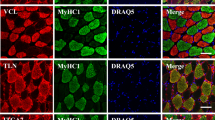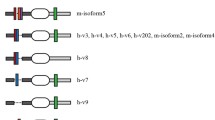Abstract
Adult fast- and slow-twitch skeletal muscle fibers exhibit characteristic differences in functional properties due to differences in the isoforms and quantities of expression of most muscle proteins. However, these differences may be reversed by chronic electrical stimulation of denervated muscle with the pattern typical of the other fiber type. Here, we review three possible signaling pathways that may contribute to fast to slow fiber type transformation. The first pathway involves cytosolic activation of the Ca2+ sensitive posphatase calcineurin (CaN) due to elevated cytosolic [Ca2+], resulting in dephosphorylation of cytoplasmic NFATc, translocation of dephosphorylated NFATc from cytoplasm into the nucleus and activation of slow fiber gene expression by NFATc in the nucleus. The second pathway involves elevated intranuclear [Ca2+] causing the activation of nuclear calmodulin dependent protein kinase, which phosphorylates HDAC within the nucleus and thereby permits nuclear efflux of HDAC, thus decreasing the HDAC suppression of MEF2 activation of slow fiber gene expression. The third possible pathway involves nuclear entry of CaN, dephosphorylation of intranuclear MEF2 and consequent increased activation of slow fiber type gene expression by dephosphorylated MEF2. Evidence for the first two pathways from our studies on adult fast twitch skeletal muscle fibers is briefly reviewed.
Similar content being viewed by others

References
Antos CL, McKinsey TA, Frey N, Kutschke W, McAnally J, Shelton JM, Richardson JA, Hill JA, Olson EN (2002). Activated glycogen synthase-3 beta suppresses cardiac hypertrophy in vivo. Proc Natl Acad Sci USA 99: 907–912
Bassel-Duby R, Olson EN (2003). Role of calcineurin in striated muscle: development, adaptation, and disease. Biochem Biophys Res Commun 311: 1133–1141
Beals CR, Clipstone NA, Ho SN, Crabtree GR (1997). Nuclear localization of NF-ATc by a calcineurin-dependent, cyclosporin-sensitive intramolecular interaction. Genes Dev 11: 824–834
Berger I, Bieniossek C, Schaffitzel C, Hassler M, Santelli E, Richmond TJ (2003). Direct interaction of Ca2+/calmodulin inhibits histone deacetylase 5 repressor core binding to myocyte enhancer factor 2. J Biol Chem 278: 17625–17635
Bertos NR, Wang AH, Yang X (2001). Class II histone deacetylases: Structure, function, and regulation. Biochem Cell Biol 79: 243–252
Billeter R, Heizmann CW, Howald H, Jenny E (1981). Analysis of myosin light and heavy chain types in single human skeletal muscle fibers. Eur J Biochem 116: 389–395
Bukard N, Becher J, Heindl C, Neyses L, Schuh K and Ritter O (2005) Targeted proteolysis sustains calcineurin activation. Circulation 111: 1045–1053
Carroll SL, Klein MG, Schneider MF (1995). Calcium transients in intact rat skeletal muscle fibers in agarose gel. Am J Physiol 269: C28–C34
Carroll SL, Klein MG, Schneider MF (1997). Decay of calcium transients after electrical stimulation in rat fast- and slow-twitch skeletal muscle fibres. J Physiol 501: 573–588
Chin ER, Olson EN, Richardson JA, Yang Q, Humphries C, Shelton JM, Wu H, Zhu W, Bassel-Duby R, Williams RS (1998). A calcineurin-dependent transcriptional pathway controls skeletal muscle fiber type. Genes Dev 12: 2499–2509
Crabtree GR (1999). Generic signals and specific outcomes: signaling through Ca2+, calcineurin, and NF-AT. Cell 96: 611–614
Downes M, Ordentlich P, Kao HY, Alvarez JGA, Evans RM (2000). Identification of a nuclear domain with deactylase activity. Proc Natl Acad Sci USA 97: 10330–10335
Faulkner G, Pallavicini A, Comelli A, Salamon M, Bortoletto G, Ievolella C, Trevisan S, Kojic’ S, Dalla Vecchia F, Laveder P, Valle G, Lanfranchi G (2000). FATZ, a filamin-, actinin-, and telethonin-binding protein of the Z-disc of skeletal muscle. J Biol Chem 275: 41234–41242
Fischle W, Kiermer V, Dequiedt F, Verdin E (2001). The emerging role of class II histone deacetylases. Biochem Cell Biol 79: 337–348
Frey N, Richardson JA, Olson EN (2000). Calsarcins, a novel family of sarcomeric calcineurin-binding proteins. Proc Natl Acad Sci USA 97: 14632–14637
Frey N, Olson EN (2002). Calsarcin-3, a novel skeletal muscle-specific member of the calsarcin family, interacts with multiple Z-disc proteins. J Biol Chem 277: 13998–134004
Frey N, Barrientos T, Shelton JM, Frank D, Rutten H, Gehring D, Kuhn C, Lutz M, Rothermel B, Bassel-Duby R, Richardson JA, Katus HA, Hill JA, Olson EN (2004). Mice lacking calsarcin-1 are sensitized to calcineurin signaling and show accelerated cardiomyopathy in response to pathological biomechanical stress. Nat Med 10: 1336–1343
Grozinger CM, Schreiber SL (2000). Regulation of histone deacetylase 4 and 5 and transcriptional activity by 14–3-3-dependent cellular localization. Proc Natl Acad Sci USA 97: 7835–7840
Hoey T, Sun YL, Williamson K, Xu X (1995). Isolation of two new members of the NF-AT gene family and functional characterization of the NF-AT proteins. Immunity 2: 461–472
Hollingworth S, Zhao M, Baylor SM (1996). The amplitude and time course of the myoplasmic free [Ca2+] transient in fast-twitch fibers of mouse muscle. J Gen Physiol 108: 455–469
Huber B, Pette D (1996). Dynamics of parvalbumin expression in low-frequency-stimulated fast-twitch rat muscle. Eur J Biochem 236: 814–819
Kelly AM, Rubinstein NA (1994). The Diversity of Muscle Fiber Types and its Origin During Development. McGraw Hill, Myology, pp. 119–133
Kiselyov KI, Shin DM, Wang Y, Pessah IN, Allen PD, Muallem S (2000). Gating of store-operated channels by conformational coupling to ryanodine receptors. Mol Cell 6: 421–431
Klein MG, Kovacs L, Simon BJ, Schneider MF (1991). Decline of myoplasmic Ca2+, recovery of calcium release and sarcoplasmic Ca2+ pump properties in frog skeletal muscle. J Physiol 441: 639–671
Kubis HP, Haller EA, Wetzel P, Gros G (1997). Adult fast myosin pattern and Ca2+-induced slow myosin pattern in primary skeletal muscle culture. Proc Natl Acad Sci USA 94: 4205–4210
Kubis HP, Scheibe RJ, Meissner JD, Hornung G, Gros G (2002). Fast-to-slow transformation and nuclear import/export kinetics of the transcription factor NFATc1 during electrostimulation of rabbit muscle cells in culture. J Physiol 541: 835–847
Kubis HP, Hanke N, Scheibe RJ, Meissner JD, Gros G (2003). Ca2+ transients activate calcineurin/NFATc1 and initiate fast-to-slow transformation in a primary skeletal muscle culture. Am J Physiol Cell Physiol 285: C56–C63
Kurebayashi N, Ogawa Y (2001). Depletion of Ca2+ in the sarcoplasmic reticulum stimulates Ca2+ entry into mouse skeletal muscle fibres. J Physiol 533: 185–199
Liu Y, Cseresnyes Z, Randall WR, Schneider MF (2001). Activity-dependent nuclear translocation and intranuclear distribution of NFATc in adult skeletal muscle fibers. J Cell Biol 155: 27–39
Liu Y, Randall WR, Schneider MF (2005). Activity-dependent and -independent nuclear fluxes of HDAC4 mediated by different kinases in adult skeletal muscle. J Cell Biol 168: 887–897
Liu Y, Schneider MF (1998). Fibre type-specific gene expression activated by chronic electrical stimulation of adult mouse skeletal muscle fibres in culture. J Physiol 512: 337–344
McCullagh KJ, Calabria E, Pallafacchina G, Ciciliot S, SerranoAL, Argentini C, Kalhovde JM, Lomo T, Schiaffino S (2004). NFAT is a nerve activity sensor in skeletal muscle and controls activity-dependent myosin switching. Proc Natl Acad Sci USA 101: 10590–10595
McKinsey TA, Zhang CL, Olson EN (2001). Control of muscle development by dueling HATs and HDACs. Curr Opin Genet Dev 11: 497–504
Mejat A, Ramond F, Bassel-Duby R, Khochbin S, Olson EN, Schaeffer L (2005). Histone deacetylase 9 couples neuronal activity to muscle chromatin acetylation and gene expression. Nat Neurosci 8: 313–321
Miska EA, Karlsson C, Langley E, Nielsen SJ, Pines J, Kouzarides T (1999). HDAC4 deacetylase associates with and represses the MEF2 transcription factor. EMBO J 18: 5099–5107
Naya FJ, Mercer B, Shelton J, Richardson JA, Williams RS, Olson EN (2000). Stimulation of slow skeletal muscle fiber gene expression by calcineurin in vivo. J Biol Chem 275: 4545–4548
Neal JW, Clipstone NA (2001). Glycogen synthase kinase-3 inhibits the DNA binding activity of NFATc. J Biol Chem 276: 3666–3673
Pan Z, Yang D, Nagaraj RY, Nosek TA, Nishi M, Takeshima H, Cheng H, Ma J (2002). Dysfunction of store-operated calcium channel in muscle cells lacking mg29. Nat Cell Biol 4: 379–383
Pette D, Staron RS (1997). Mammalian skeletal muscle fiber type transitions. Int Rev Cytol 170: 143–223
Pette D, Vrbova G (1985). Invited review: neural control of phenotypic expression in mammalian muscle fibers. Muscle Nerve 8: 676–689
Powell JA, Carrasco MA, Adams DS, Drouet B, Rios J, Muller M, Estrada M, Jaimovich E (2001). IP3 receptor function and localization in myotubes: an unexplored Ca(2+) signaling pathway in skeletal muscle. J Cell Sci 114: 3673–3683
Rosenberg P, Hawkins A, Stiber J, Shelton JM, Hutcheson K, Bassel-Duby R, Shin DM, Yan Z, Williams RS (2004). TRPC3 channels confer cellular memory of recent neuromuscular activity. Proc Natl Acad Sci USA 101: 9387–9392
Salazar C, Hofer T (2003). Allosteric regulation of the transcription factor NFAT1 by multiple phosphorylation sites: a mathematical analysis. J Mol Biol 327: 31–45
Schiaffino S, Serrano A (2002). Calcineurin signaling and neural control of skeletal muscle fiber type and size. Trends Pharmacol Sci 23: 569–575
Sheridan CM, Heist EK, Beals CR, Crabtree GR, Gardner P (2002). Protein kinase A negatively modulates the nuclear accumulation of NF-ATc1 by priming for subsequent phosphorylation by glycogen synthase kinase-3. J Biol Chem 277: 48664–48676
Shibasaki F, Price ER, Milan D, McKeon F (1996). Role of kinases and the phosphatase calcineurin in the nuclear shuttling of transcription factor NF-AT4. Nature 382: 370–373
Sparrow DB, Miska EA, Langley E, Reynaud -Deonauth S, Kotecha S, Towers N, Spohr G, Kouzarides T, Mohun TJ (1999). MEF-2 function is modified by a novel co-repressor, MITR. EMBO J 18: 5085–5098
Sreter FA, Lopez JR, Alamo L, Mabuchi K, Gergely (1987). Changes in intracellular ionized Ca concentration associated with muscle fiber type transformation. Am J Physiol Cell Physiol 253: C296–C300
Tomida T, Hirose K, Takizawa A, Shibasaki F, Iino M (2003). NFAT functions as a working memory of Ca2+ signals in decoding Ca2+ oscillation. EMBO J 22: 3825–3932
Wada M, Hamalainen N, Pette D (1995). Isomyosin patterns of single type IIB, IID and IIA fibres from rabbit skeletal muscle. J␣Musc Res Cell Motil 163: 237–242
Westerblad H, Allen DG (1994). Relaxation, [Ca2+]i and [Mg2+]i during prolonged tetanic stimulation of intact, single fibres from mouse skeletal muscle. J Physiol 480: 31–43
Windisch A, Gundersen K, Szabolcs MJ, Gruber H, Lomo T (1998). Fast to slow transformation of denervated and electrically stimulated rat muscle. J Physiol 510: 623–632
Wu H, Naya FJ, McKinsey TA, Mercer B, Shelton JM, Chin ER, Simard AR, Michel RN, Bassel-Duby R, Olson EN, Williams RS (2000). MEF2 responds to multiple calcium-regulated signals in the control of skeletal muscle fiber type. EMBO J 19: 1963–1973
Wu H, Rothermel B, Kanatous S, Rosenberg P, Naya FJ, Shelton JM, Hutcheson KA, DiMaio JM, Olson EN, Bassel-Duby R, Williams RS (2001). Activation of MEF2 by muscle activity is mediated through a calcineurin-dependent pathway. EMBO J 20: 6414–6423
Yu YT (1996). Distinct domains of myocyte enhancer binding factor-2A determining nuclear localization and cell type-specific transcriptional activity. J Biol Chem 271: 24675–24683
Zhang CL, McKinsey TA, Olson (2001). The transcriptional corepressor MITR is a signal-responsive inhibitor of myogenesis. Proc Natl Acad Sci USA 98: 7354–7359
Zimber A, Nguyen QD, Gespach C (2004). Nuclear bodies and compartments: functional roles and cellular signalling in health and disease. Cell Signal 16: 1085–1104
Acknowledgements
We thank Ms Carrie Wagner and Mr. Jonathan Martin for preparation of Figures 1, 2, 5, and 6. This work was supported by National Institutes of Health grant R01-NS33578 from the National Institute of Neurological Disorders and Stroke. T. Shen is supported by NIH Training Grant T32-AR-07592 to the Interdisciplinary Program in Muscle Biology , University of Maryland School of Medicine.
Author information
Authors and Affiliations
Corresponding author
Rights and permissions
About this article
Cite this article
Liu, Y., Shen, T., Randall, W.R. et al. Signaling pathways in activity-dependent fiber type plasticity in adult skeletal muscle. J Muscle Res Cell Motil 26, 13–21 (2005). https://doi.org/10.1007/s10974-005-9002-0
Received:
Revised:
Accepted:
Published:
Issue Date:
DOI: https://doi.org/10.1007/s10974-005-9002-0



